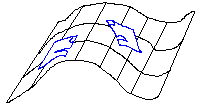
Some people say that Time is the 4th dimension. This is, in a sense, true. However, time is not the "different direction" of which I was speaking. If we want to count time as a dimension, then we should say that we live in a four dimensional space-time that is curved into the 5th dimension! So where is this "different direction"?
2.2 Flatland
It is very difficult to visualize four dimensions of space.
In 1884, a Victorian schoolmaster, Edwin Abbott, published a book about
an imaginary two-dimensional world called Flatland. Flatland is inhabited
by creatures that slide about. We might think of them as being like
coins on a tabletop. Alternatively, we could think of them as colored
patterns in a soap film. The story focus on the adventures of A Square,
Flatland's most famous citizen, and his path to an understanding of the
third dimension. By thinking about A Square's difficulties in understanding
the third dimension, we become better able to deal with our own problems
with the fourth dimension. Early in the story, A Square and
his wife are comfortably sealed up in the safety of their home, when suddenly
a voice out of nowhere speaks to them. And then, a moment later,
a circle appears in the confines of their tightly locked house. It
is A Sphere, come to teach A Square about the third dimension:


2.3 Ourland
This bulging out into the 4th dimension that our universe seems to
do occurs on three different scales: Small-scale curvature results
from each subatomic particle. Medium-scale curvature is associated
with gravitational attraction of stars, black holes, and galaxies.
Large-scale curvature is the overall shape of space, and is the cumulative
result of the totality of all the mater and energy in space. To make
clear what is meant by different "scales of curvature", consider the following:
On the large-scale, we say that the surface of the Earth is curved into
the shape of a sphere that bulges a bit at the equator. On the medium,
human-sized scale, we notice that the Earth's surface is covered with hills
and valleys. And on the small scale, the Earth's surface breaks into
individual rocks and clods of dirt.
On the large-scale, much of space has a particular kind of curvature
called Hyperbolic Space. Hyperbolic Space has its own geometry,
Hyperbolic Geometry, which has many similarities to our usual Euclidean
Geometry, but also has some striking differences. In a sense, Euclidean
Geometry can be thought of as a subset of Hyperbolic Geometry since a small
chunk of Hyperbolic Space has small curvature, and very closely matches
Euclidean Space. All geometric theorems of Euclidean Geometry, therefore,
appear to be true in a small chunk of Hyperbolic Space.
2.4 Mercury's Orbit
The distance from the Earth to the Sun is much too small for our most
sensitive instruments to measure any of the differences between Euclidean
and Hyperbolic Geometry caused by the large-scale curvature of space.
However, our Sun causes some medium-scale curvature that - thanks
to planet Mercury - we are able to measure. Mercury is the closest
planet to the Sun. It is in a much higher gravitational field
than is the Earth, and therefore, space is significantly more curved in
its vicinity. Mercury is close enough to us so that, with telescopes,
we can make accurate measurements of its motion. Mercury's orbit
about the Sun is slightly more accurately predicted when Hyperbolic
Geometry is used in place of Euclidean Geometry.